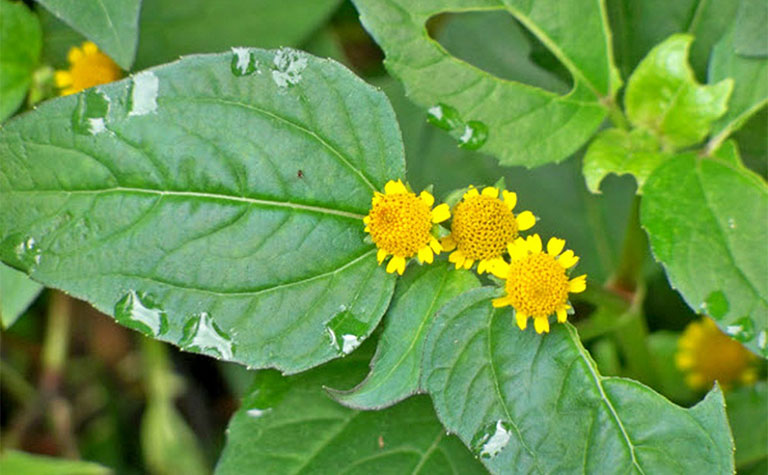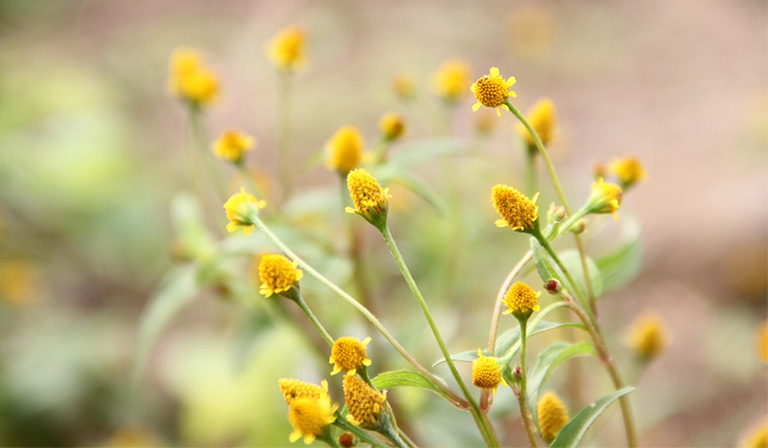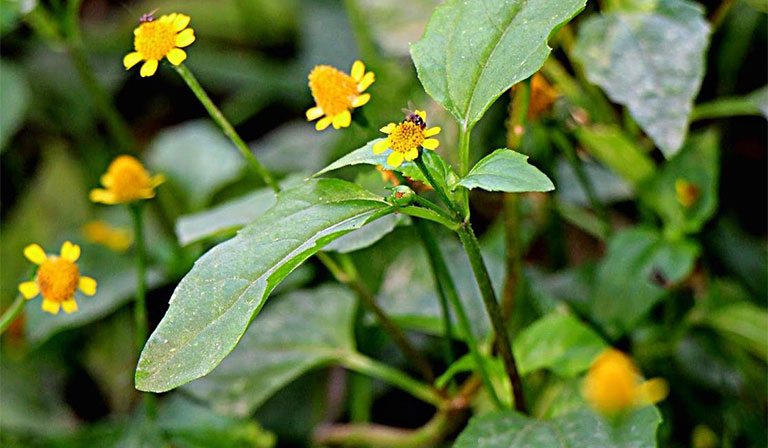Wild Chrysanthemum grows in nature, often used to treat toothache, rheumatism, poisoning, edema, colds, stomach pain. In addition, it is also used to treat tongue paralysis, headache, sore throat.

Yellow Chrysanthemum is often used to reduce inflammation and treat toothache and gingivitis
Other names: Chrysanthemum, Ngo Ao, Knot Ao, Yellow Bud, Yellow Chrysanthemum, Therme, Cúc Lác, Cỏ Nhỏ, Hàn Phát Khắc Scientific name: Spilanthes acmella L. Murr.
Family: Asteracea
Description of the medicinal herb Chrysanthemum
1. Ecological characteristics
Yellow Chrysanthemum is a small plant, growing upright or creeping on the ground, divided into many branches, can be about 0.4 – 0.7 m high. Yellow Chrysanthemum leaves are oval or elongated, the edges of the leaves have large serrations or are slightly wavy. The leaf blade is about 3 – 7 cm long, about 1 – 3 cm wide.
Flowers grow in clusters at the top of the branch, slightly conical, flagged edges, light color, about 2 – 3 mm long. The flowers are flat, with oval bracts, pointed at the tip, yellow corolla, the flowers in the middle are tubular. The fruit is flat, light brown, with 2 teeth at the tip.
The flowering season starts from 1 – 5 days later.
2. Medicinal parts
The whole body or flower of the Chrysanthemum is used as a medicinal herb with the medicinal name Herba seu Flos Spilanthi.
3. Distribution
The Chrysanthemum is a tropical herbaceous plant, often growing along roadsides, river banks and under the canopy of humid dense forests, along streams from the plains up to 1,500 meters in altitude.
Currently, many places grow the yellow Chrysanthemum from seeds or seedlings in the spring for medicinal purposes.
4. Harvesting – Preliminary processing
Harvest the whole plant, can be used fresh or washed, dried and stored for later use.
When harvesting, pick the flowers when they are still green to get the best quality of medicinal herbs.
5. Preserving medicinal herbs
Store the Button plant in a dry, cool place, avoid high humidity.
6. Chemical composition
The essential oil of the flower and the stem of the Button plant contains:
Spilanthol
Non-reducing polysaccharide
Sterol
The flower cluster and the whole plant contain a pungent essential oil with the main ingredients including:
Spilanten
A liquor called Spilantola
Medicinal herbs of the Button plant
The Button plant has a bitter, warm taste and is often used to reduce swelling, relieve pain, and detoxify
The taste of the medicine of the shirt button

1. Properties
The yellow-flowered Button plant has a bitter taste, is warm, and contains little toxicity.
Wild plants have stronger numbing properties than cultivated plants, especially in flower clusters, if touched can cause drooling.
2. Pharmacological effects
According to modern medicine:
Inhibits the activity of prostate cancer cells. However, it has little effect on normal Vero cells.
Anti-lung and breast cancer activity.
According to traditional medicine:
Reduce swelling
Relieve pain
Detoxify
Disperse blood stasis
Main treatments:
Headache, cold, intermittent malaria, sore throat
Whooping cough, tuberculosis, asthma, bronchitis
Tooth decay, toothache
Paralysis, rheumatism, bone pain
Used externally to treat poisonous boils, itching, hives, itching, poisonous snake bites, painful swelling and hematoma.
3. How to use – Dosage
Chrysanthemum flowers can be taken orally or crushed and applied externally, can be used alone or combined with other medicinal herbs.
Recommended dosage:
4 – 12 g, decocted to drink.
For external use, the dosage is not fixed, depending on the need.
Medicine using Chrysanthemum
Chrysanthemum flowers

Chrysanthemum flowers are used to relieve pain, treat hives and itching
1. Treat colds, headaches, malaria, sore throat
Use 4 – 12 g of fresh Chrysanthemum flowers, decocted into medicine for drinking.
2. Treat malaria
Use 20 g of Chrysanthemum flowers, decocted into medicine, taken before a malaria attack.
3. Treat sore throat, toothache
Use Chrysanthemum flowers, ground into fine powder, soaked in alcohol or held fresh, swallowed for treatment.
4. Treat rheumatism
Use Chrysanthemum roots, Vajra roots, Lemon roots, Sichuan pepper roots, and Mang tang fruit, each with a dosage of 4 – 8 g, decocted into medicine, taken orally.
5. Treating boils, scabies, snake bites, hematomas, sore eyes
Use 4-12g of the whole Chrysanthemum plant or 4-8g of the root, decoct it into medicine, drink it. Combine it with the use of fresh Chrysanthemum plant, wash it, crush it and apply it on the skin to increase the treatment effect.
Use 60g of the Knot Ao, wash it, boil it to get the water and drink it twice a day.





